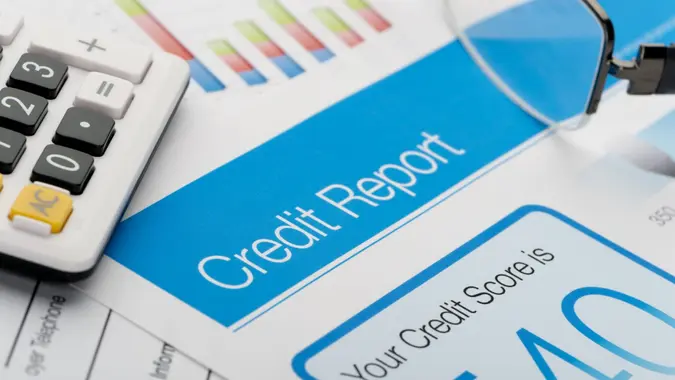Writing a Goodwill Letter: How to Request Late Payment Forgiveness

Commitment to Our Readers
GOBankingRates' editorial team is committed to bringing you unbiased reviews and information. We use data-driven methodologies to evaluate financial products and services - our reviews and ratings are not influenced by advertisers. You can read more about our editorial guidelines and our products and services review methodology.

20 Years
Helping You Live Richer

Reviewed
by Experts

Trusted by
Millions of Readers
Payment history is a major consideration when it comes to calculating your credit score, making up 35% of your total score. A single late payment — which happens 30 days or more after the payment was due — can have a significant impact.
Goodwill letters are formal requests to creditors or lenders that ask them to remove or adjust a late payment so it doesn’t impact your credit score. These letters may explain why the payment was late, and are typically most effective if the late payment was a one-time occurrence and you’re otherwise in good standing with the lender.
Does a Goodwill Letter Really Work?
Goodwill letters can be effective, especially in the following conditions:
- One-time mistake: If you have a single late payment and an otherwise pristine credit history, and your account is in good standing.
- Extenuating circumstances: Medical emergencies, job loss, a death in the family or natural disasters can all be considered extenuating circumstances.
- Technical issues: Technical issues like a mobile app not working, internet not working, auto-payments failing to process or payment processing issues.
- Long-term history: Customers of five years are more likely to be favored compared to brand-new customers.
Smaller, regional financial institutions may have the capacity to be more flexible compared to large banks with more rigid policies. Some lenders may also have policies in place, like requiring two years to pass after one goodwill exception for another will be approved.
Goodwill exceptions are never guaranteed, even in the circumstances detailed above.
How to Write an Effective Goodwill Letter
To write an effective goodwill letter that increases the chance of late payment forgiveness, follow these five steps.
Step 1: Gather Your Account Details
Start by checking your credit report for accurate and updated information.
Identify the late payment’s date and the amount reported. You should also collect the lender’s contact information.
Step 2: Explain Your Situation Honestly
When writing the letter, briefly describe why the late payment happened.
It’s important to explain while still taking responsibility, which can include offering solutions to prevent late payments in the future. If you didn’t receive a mailed statement and forgot to pay, for example, you can tell the lender that you now set up email or text alerts before a payment is due.
Don’t forget to stress your past good payment history or your long standing relationship with the lender.
Step 3: Request Late Payment Removal Politely
Politely and professionally request that the late payment is removed from your credit score. Acknowledge that while the payment was your responsibility, you’re requesting a goodwill exception.
At this point, make sure you express gratitude. You can also explain how removal would help your credit score, and how that may impact your immediate and long-term financial goals.
Step 4: Provide Supporting Evidence (If Applicable)
If you have supporting evidence that supports your case, you can include it in the letter. You may include a copy of an emergency medical bill, for example, that proved that you were ill when the payment was due. You can also show proof of job loss to explain recent financial struggles.
Showing financial recovery or proof of the extenuating circumstances can help improve your chances of a goodwill exception approval.
Step 5: Proofread and Send Your Letter
Review your goodwill letter carefully. You can use a tool like Grammarly to check for grammar and syntax, and don’t be afraid to ask a trusted friend or family member to review it, too.
Make sure that the letter is both clear and professional, and that it thanks the lender for their time.
Once you’ve written it, you can send it through mail, email, or the company’s online portal. Some companies recommend sending the letter by certified mail, so you have proof that it was accepted.
Goodwill Letter Template for Late Payment Removal
Your goodwill letter should include the following elements:
- Your personal information, including your name, address, account number, phone number.
- The date you’re writing the goodwill letter.
- A professional greeting, such as “To whom it may concern.”
- A clear request that states upfront that you’re requiring a goodwill adjustment.
- Explanation of circumstances that honestly describes what caused the late payment.
- Take responsibility for the late payment.
- Highlight of what works in your favor, including a longstanding relationship with the company, a high annual fee, or a pristine credit history.
- Information about how the late payment could impact your financial goals, such as a mortgage application or an auto loan.
- Note detailing that the account is now current or paid in-full.
- Polite request for the act of goodwill.
- A note of thanks for their time and consideration.
- Your signature.
The letter should be concise, no more than one page long. It should read both professional and sincere.
Goodwill Letter Template
Here’s a template that you can use for inspiration, but remember to personalize it for best results:
To whom it may concern,
I am writing to request a goodwill adjustment to remove a late payment reported on my account referenced above. According to my credit report, a payment was reported late on [exact date of late payment].
The late payment occurred due to [brief, honest explanation of the circumstances].
I understand that making timely payments is my responsibility, and I apologize for the delay. I’ve taken several steps to ensure the situation doesn’t happen in the future, including [list reasons like setting up automatic payments, establishing an emergency fund, or enabling email reminders before payments are due].
I’ve been a loyal customer of [creditor name] since [year you first opened an account with the company]. During this time, I’ve maintained a positive payment history.
This late payment is an unfortunate exception to my otherwise consistent record. Given my history and since my account is now current, I respectfully request that a goodwill exception be applied in my case so the late payment can be removed from my credit score. I plan to apply for a mortgage in the coming months to purchase my first home, and this would go a long way.
Thank you for your time and consideration of my request. I greatly appreciate our relationship and look forward to continuing as a valued customer for many years to come.
Sincerely,
[Your Signature]
[Your Printed Name].
What to Do If Your Goodwill Letter Is Denied
If your goodwill letter is denied, you can try the following tactics:
- Try again with a revised request, which may include a more detailed explanation.
- Contact customer service by phone or email for a direct appeal, and ask to speak to a supervisor if needed.
- Request debt validation or verification, which involves asking the creditor to verify the debt and its reporting accuracy. If they can’t provide proper documentation, they may have to remove the negative item.
If these strategies don’t work and the late payment isn’t removed from your credit score, you can focus on building a positive history.
Alternatives to a Goodwill Letter
If a goodwill letter doesn’t work, you may consider the following solutions:
- Wait for late payments to come off your credit report, which takes seven years.
- Negotiating a pay-for-delete agreement, where they agree to remove the report to your credit score after you pay in full.
- Build positive credit habits such as making on-time payments with all other accounts, keeping debt utilization low, and maintaining a combination of different credit types to improve your overall profile.
Looking for more information about improving your credit score? You can review our resources here.
Our in-house research team and on-site financial experts work together to create content that’s accurate, impartial, and up to date. We fact-check every single statistic, quote and fact using trusted primary resources to make sure the information we provide is correct. You can learn more about GOBankingRates’ processes and standards in our editorial policy.
 Written by
Written by  Edited by
Edited by 






















